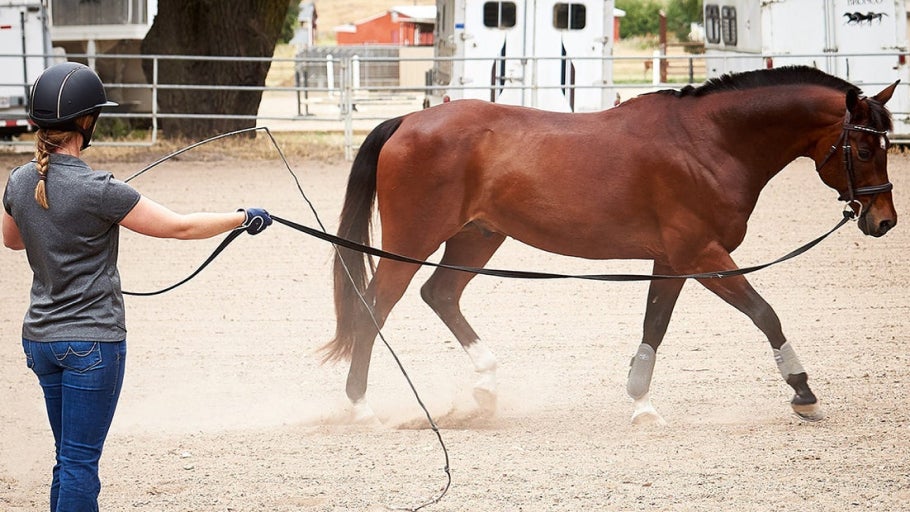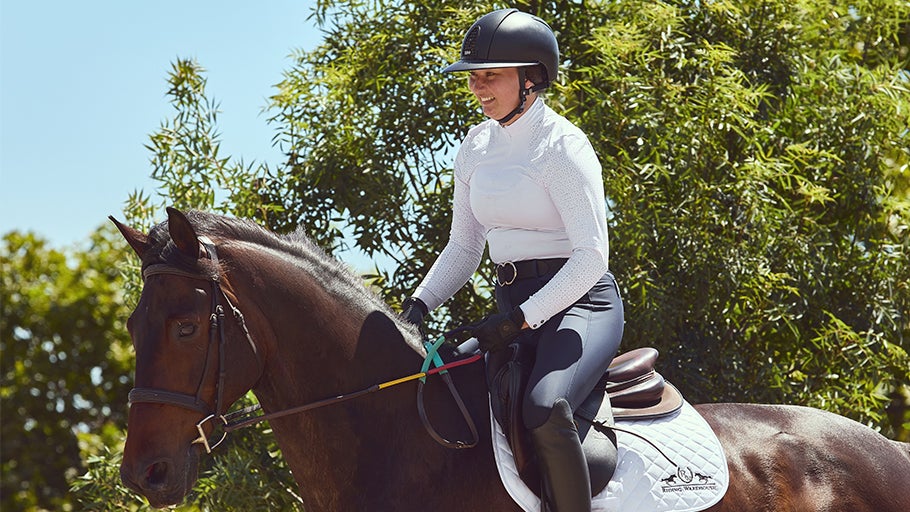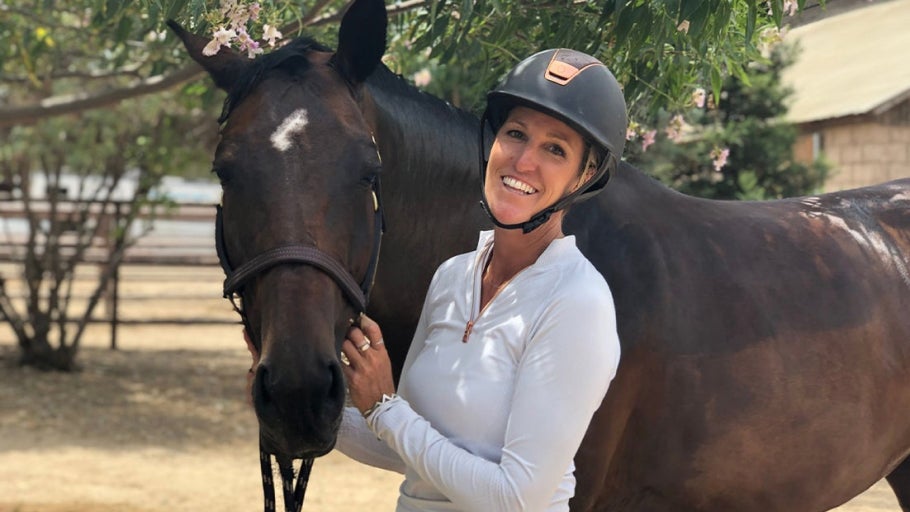
How to Set Ground Pole Exercises for Your Horse
Work over ground poles can be beneficial for horses and riders of all disciplines and experience levels. These types of exercises reinforce important basics like rhythm, impulsion, straightness, balance, and more. As you and your horse navigate ground poles, you should focus on the quality of your horse's gait while they perform the exercise at hand. The ultimate goal is to improve your horse's strength and flexibility so that they can perform better at everything they do. In this article, we will cover some general ground pole tips as well as how to set specific exercises for the walk, trot, and canter.
Benefits of Ground Pole Exercises
Ground pole exercises are useful for riders in any discipline. The poles help horses engage their core and lift their back while keeping the actual impact as low as possible. Even just walking through pole exercises is a great way for horses to engage their body. In the walk, there are no moments of suspension, this means that the muscles are doing every bit of work (with no inertia drastically taking them forward). The poles make horses bend their hocks, increase mobility in their pelvis, and emphasize the use of their core and hind end.
Pole exercises are great for horses who need to build or rebuild strength. This means that horses who are rehabbing can benefit greatly. It is a mental task in addition to a physical one that helps the rider calm the storm that is a rehabbing horse.
Building a strong foundation with a good understanding of rhythm, impulsion, straightness, balance, and suppleness is important for any rider and horse combination. From walking over poles to gymnastic grids, we hope that the information here will equip you with the knowledge you need to incorporate poles into your routine, and as a result produce a happier, healthier, and stronger horse.
Pro Tip
When measuring poles, a common method is walking heel to toe, or counting the boot lengths between poles. It's useful to know how many of your boot lengths fit into a meter-long step since that is another common unit of measurement.
Before You Get On
Setting up your pole exercise before you get on your horse is a safe way to check the arena you're riding in for rocks and debris, as well as making it easier to grab, move around, and measure poles. The best poles to use, especially for horses new to exercise, are solid wooden poles. This is because they aren't going to move as much if the horse knocks one while going over it.
Distances will be covered throughout the article, but below is a quick guide. All of the distances covered in this article are based on an average horse's stride length. If you have a pony or extra-large horse, you will likely have to adjust the distances so that they fit your horse's movement more easily.
- 1 average human step = 2.5 ft = 1 average (horse) walk step
- 1 large human step = 3 ft = 1 average trot step
- 4 human steps = 12 ft = 1 average canter stride
- 1 large human step = 3 ft = take-off and landing allowance for cantering over poles
Ground pole exercises exist for every rider and every horse, regardless of discipline or level. The beauty of these exercises is that they can be altered for any horse. On average, poles set at a walking distance will be around 2.5 to 3 ft, trotting at 3 to 4 ft, and cantering at 9 to 12 ft. If you have a shorter-stride horse or pony, use the shorter distances in these ranges. If you have an average or large horse, use the larger end of the range.
Getting Started with Ground Poles
Start simple, especially if your horse hasn't been over ground poles before. Set one single pole on the ground in an open, flat area. Introduce your horse to the pole by walking, then trotting straight over it. Once they are comfortable with that, you can add another pole several strides away. In the beginning, you don't want to overwhelm the horse with multiple poles in a row.
Pro Tip
It's tempting to pick and pull our way to a pole, but resist! You should ride a pole as if it were just another stride in the horse's path. Really focus on keeping the same pace (counting 1-2-3-4 in the walk, 1-2-1-2 in the trot, and 1-2-3-1-2-3 in the canter helps), and the distance to the pole will work itself out.
When walking out the distance between poles, it is helpful to know what a one-meter (or three-foot) long step looks like for you. A step this size is generally assumed to be equivalent to one trot step for an average-size horse. In other words, if you take ten steps between the first and second poles, then your horse should also take ten trot steps between the poles. If you are working at the walk, the strides will be a bit shorter than one meter, so you will want to take shorter steps.
Multiple Walk or Trot Poles in a Row
After it becomes easy to traverse the poles that are several strides apart, you can set a few poles in a row. The poles should be spaced about three to four boot lengths apart when you plan to walk over them. To trot over the poles, space them about four-and-a-half to five boot lengths (or one big step) apart. If you find that the poles are too close or far apart for your horse, don't be afraid to make an adjustment.
When starting out over poles, you don't want the horse to strain to get across them. Once they become more comfortable with the exercise, you can adjust the poles to ask for a collected or lengthened trot step. To ask for a shorter, more collected stride, decrease the distance between the trot poles slightly. On the other hand, you can ask for a lengthened step by increasing that distance a bit.
Pro Tip
It is important to keep your same pace and rhythm through the poles; make sure you don't take your leg off as you go over the first pole. Keep riding the whole way through the grouping!
Introducing Canter & Lope Poles
You can also perform pole work at the lope or canter. Once again, you should start by cantering over a single pole so that your horse isn't surprised by the exercise. When that becomes easy, you can add another pole several strides away. It is generally assumed that the average horse's canter stride is about 12 feet long. Since a human step is around three feet long, we can determine that four human steps cover roughly the same distance as one horse canter stride. This equation is important to keep in mind when setting up ground poles or even walking a course.
For your horse to successfully canter over poles, you should also consider the distance they need for take-off and landing. When working over ground poles, we assume that the horse needs one human step to land from the first pole, and then another human step when taking off for the second pole. Therefore, if you wanted to set two poles one stride apart, that would be about six human steps: one step for landing, four steps to roughly equal a stride, and then one step for take-off. You can put as many strides as you would like between the two poles, just remember that each additional stride for the horse is about four human steps.
Pro Tip
Make sure to ride the same rhythm through the poles. Changing your canter right before or in between makes it harder for the horse to get an even distance to the pole. Your approach canter should be the same as the canter that you have over and in between the poles.
Challenge: Set two poles 6 strides apart and play around with how many strides you can get in between. If you're aiming for 6 strides in between, come in with your normal balanced canter and keep it consistent through the poles. If you want to aim for 7 strides in between, you'll have to collect and shorten your horse's stride early in preparation for the poles. Again, your approach canter should match the canter you want in the middle of the poles. Watch our Sponsored Rider, Amanda Garcia, explain this pole challenge so you can try it at home!
Multiple Canter or Lope Poles in a Row
Once you have mastered cantering over a single pole, as well as two poles several strides apart, you can put multiple canter poles in a row. When setting up this exercise, there should be about three human steps between each pole. This is the same concept as bounce jumps, where the horse is not taking any strides in between the jumps or in this case poles. You can use as many or as few poles as you would like for this exercise. Placing several poles in a row can make the exercise more challenging for your horse, so don't lose sight of the basics as you work through this. Be sure that your horse is forward, straight, rhythmic, and balanced as they go over the poles.
More Exercises with Poles
Pole exercises are useful for every single horse and rider combination, regardless of level, discipline, or end goals. Starting with basic pole exercises, such as trotting two poles, and multiple strides apart from each other, helps riders develop their eye (seeing distances to jumps or obstacles) and shows the importance of keeping a consistent rhythm. These concepts can further be applied in more complex exercises.
Cavaletti Work
Cavaletti work involves all the same concepts as ground pole work, but the difference is the poles are raised slightly off the ground. They can be raised diagonally, one side on the ground and one on a low block or standard, or they can be level with both sides raised equally. This change emphasizes the lift in the horse's hock and suspension within the gate.
Cavalettis can be used in all gaits. In the walk, since there are no moments of suspension, it makes the horse use their top-line muscles and lift their core. This is extremely relevant to trail riding and trail classes. In these classes, horses are asked to walk, trot, and lope through various pole obstacles, showcasing the horse's adjustability and responsiveness.
Dressage riders commonly use cavalettis to teach horses suspension and often use them as an introduction to upper-level movements, like a Passage and Piaffe. These exercises give horses a concrete example of the concept, which they can apply in their normal riding practices.
Curved Pole Paths
Another popular ground pole or cavaletti exercise involves curving the line of poles rather than having them in a straight line with each other. Imagine having poles on a circular path. Similar to all the previous exercises, they can be consecutive or have multiple strides in between. This is a more advanced use of poles and emphasizes the importance of a solid outside aid connection.
Grid Work
Using jumps in place of poles or cavalettis turns these exercises into "grids." Often grids include a variety of bounces, one-strides, two-strides, and placement poles so that the horse and rider can practice consistency, athleticism, and balance. Grids encourage the horse to become more upright and compact their stride while still keeping the push from behind. Grids also show the importance of straightness since the related distances will be harder to achieve if the path taken is wiggling all over the place.
Adding Jumps
Once raised jumps are incorporated, such as in a grid setting, the distance given for take-off and landing needs to be increased slightly. A standard one-stride with jumps should be 21 ft. This gives the horse 4.5 ft for take-off and landing, as well as the same 12-ft stride. Here's a table for common jump distances.
| Strides | 9-ft Stride (Pony) | 12-ft Stride (Horse) |
| Bounce | 9 ft | 12 ft |
| 1 Stride | 18 ft | 21 ft |
| 2 Stride | 27 ft | 33 ft |
| 3 Stride | 36 ft | 45 ft |
Frequently Asked Questions
What are horse ground poles? Are trot poles different?
"Ground poles" is a term for an exercise using various amounts of poles, set at a measured equal distance from each other that encourages horses and riders to develop and maintain quality gaits. Ground poles can be used in the walk, trot (i.e. trot poles), and canter/lope, but all have different recommended measurements.
What are the benefits of ground poles?
Ground poles are beneficial to every horse and rider pair. The act of stepping over a pole helps the horse engage their core and increase flexibility in their joints. All of this helps build their top-line muscles. Additionally, it teaches riders how to keep their rhythm and maintain an independent balance. Poles are a mental exercise for both horses and riders as well as a physical exercise, making them the perfect all-around drill activity.
How far apart should ground poles be for an average horse?
When setting pole exercises for your horse, it is important to note if they are smaller or larger than the average horse. We want to give our horses a fair shot at success, and if we set up poles that won't work for their size, it helps no one. Here's a general guide to pole distances:
| Gait | Feet | Boot Lengths | Steps |
| Walk | 2.5'-3' | 3-4 | 1 normal |
| Trot | 3.5'-4' | 4.5-5 | 1 large |
| Canter | 9'-12' | 12-16 |
3 normal steps (9' stride) 4 normal steps (12' stride) |
How many ground poles should you use?
However many you want! For those just starting to use poles, using one or two with more space between them is a smart way to gain confidence. Using three consecutive poles is a solid introductory amount that can be added to as you get more comfortable with poles.
Closing Thoughts
We hope that this beginner guide to ground poles helps you understand how and why we incorporate them into our riding. If you find that you are running into any problems during these exercises, don't be afraid to stop and take a moment to think through the issue or change it up. If any questions arise, be sure to consult your trainer or a trusted barn mate. Remember that safety comes first, so it's always better to check, especially when it's in regard to a new exercise. Ride on!
Related Articles











